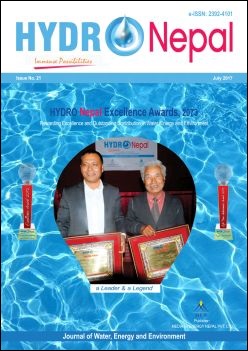Challenges in Estimating Quantitative Precipitation Estimation (QPE) Using Weather Radar Observation Over the Mountainous Country of Nepal
DOI:
https://doi.org/10.3126/hn.v21i0.17822Keywords:
Weather radar, Rainfall, Mountain, QPE, Beam blockage, NepalAbstract
South Asian country Nepal characterizes a complex mountain range in this world. The country’s population density is increasing along with rapid growth of population especially over mountainous cities, southern hills and the Terai. On the other hand, a number of fatal natural calamities, such as flash flooding and landslides raised by clutter intensive rainfall, have been increasing since the last decade. To deal with such water hydro meteorological disasters, accurate information on spatial and temporal variation of rainfall distribution is very important. In Nepal, the amount of rainfall has been obtained from limited rain gauge networks, which may leads to many errors in making a Quantitative Precipitation Estimation (QPE). Weather radar observations have recently been highlighted as an alternative option for estimating the spatial and temporal distribution of precipitation across specified time intervals. However, estimating rainfall from radar observation has its own challenges, especially over a mountainous country like Nepal.
Another mountainous country Japan is well known for using weather radar observation to make QPE product. Different types of weather radar have been used to record, monitor and forecast precipitation in Japan for both operational and research purposes. A high level research work has also been done on this field. The high spatial and temporal (250-m and 1-min) QPE product obtained from the radar observation is available for the public. It shows good harmony with ground data in the flat and mountain areas of Japan. Though Nepal and Japan are located in different regions, both countries represent complex mountain regions and have been facing natural disaster caused by extreme rainfall. In Nepal, weather radar observation for estimating precipitation amounts has not started on an operational basis till date. Hence, sharing knowledge and skills from Japan’s research on weather radar observation would play a key role to achieve the radar based QPE product in Nepal. Therefore, we discuss about the challenge in obtaining QPE product, considering an example of the progress of weather radar system in Japan. It is believed that any discussion on it will be a reference for weather radar deployment and its QPE product in Nepal in coming days.
HYDRO Nepal Journal
Journal of Water Energy and Environment
Issue: 21, July, 2017
Page: 50-59
Upload Date: July 18, 2017
Downloads
Downloads
Published
How to Cite
Issue
Section
License
The copyright of the articles and papers published is held by HYDRO Nepal Journal.
The views and interpretation in this journal are those of author(s), and HYDRO Nepal does not bear any responsibility for the views expressed by authors in the journal.




